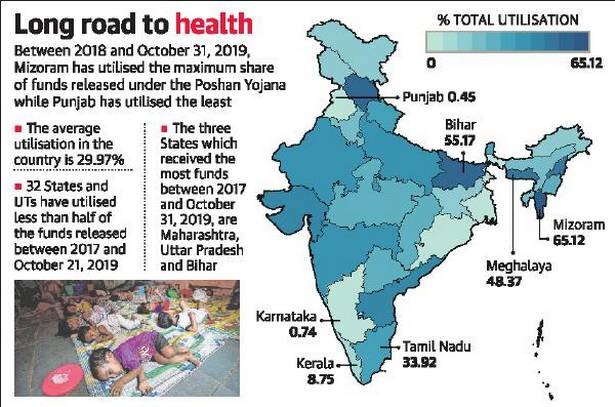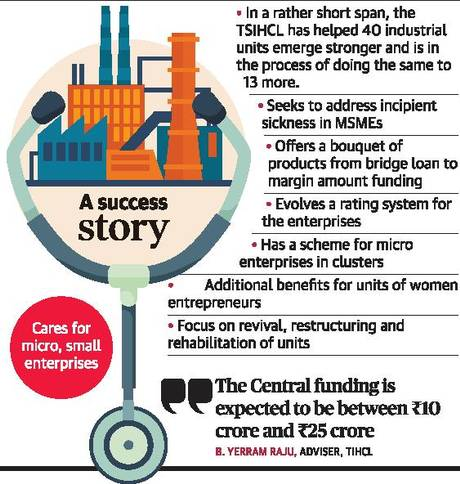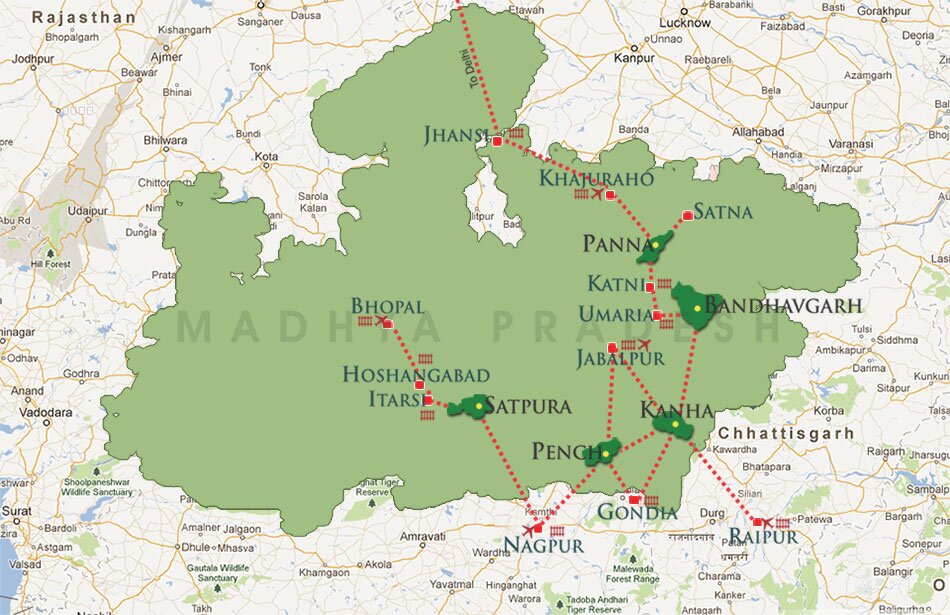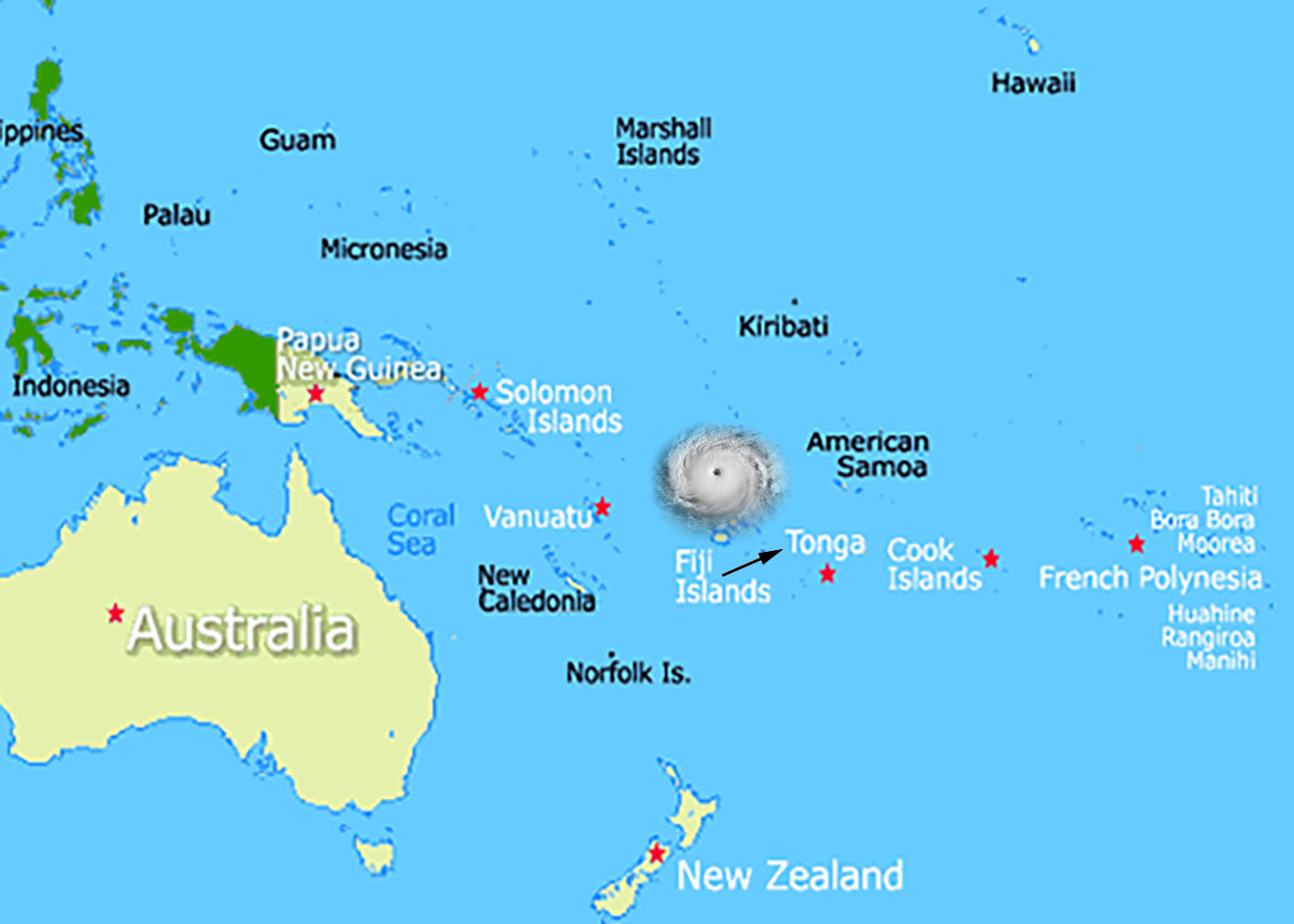Governance
Mere 30% of Poshan Abhiyaan Funds Used
Why in News
Only 30% of the funds released under the Poshan Abhiyaan have been utilised by the State governments and the Union Territories since it was launched in 2018.
- Until October 31, 2019, only 29.97% of the funds granted were used.
Key Points
- Poshan Abhiyaan:
- It is the centre’s flagship programme which aims at improving nutritional outcomes among pregnant women, lactating mothers and children by reducing the level of stunting, underweight, anaemia and low birth weight by 2022.
- It was launched to benefit more than 10 crore people with a total budget of ₹9,046.17 crore for three years.
- 50% of the total budget comes from the World Bank or other multilateral development banks and the rest of the 50% is through Centre’s budgetary support.
- Centre’s budgetary support is further divided into 60:40 between the Centre and the States, 90:10 for the north-eastern region and the Himalayan States and 100% for the Union Territories without legislature.
- Best Five Performers- Mizoram (65.12%) > Lakshadweep (61.08%) > Bihar (55.17%) > Himachal Pradesh (53.29%) > Meghalaya (48.37%).
- Worst Five Performers- Punjab (0.45%) < Karnataka (0.74%) < Kerala (8.75%) < Jharkhand (13.94%) < Assam (23.01%).
- The programme was conceptualised to be implemented in phases so the utilisation will increase over the years. Few services showed a slow start and are now pickling up like the Integrated Child Development Services-Common Application Software (ICDS-CAS).
- The Ministry of Health and Welfare released the Comprehensive National Nutrition Survey (CNNS) in October which showed that 35% of children under the age of 5 are stunted and in this age group, 17% are wasted (low weight for height) and 33% underweight (low weight for age).
Integrated Child Development Services
- The scheme provides specific interventions targeted towards the vulnerable groups include children below 6 years and women.
- It is being implemented by the Ministry of Women and Child Development.
- It provides a package of six services namely supplementary nutrition, pre-school non-formal education, nutrition & health education, immunization, health check-up and referral services.
- Common Application Software is intended to use technology for furthering of the objectives of the scheme.
Indian Economy
Telangana Industrial Health Clinic
Why in News
The Telangana Industrial Health Clinic Ltd. (TIHCL), an initiative of the State government to handhold Micro and Small Manufacturing Enterprises (MSMEs) from slipping into sickness, is ready to extend its services at pan India level.
Telangana Industrial Health Clinic Limited
- It was established in 2018 as a fintech Non-Banking Finance Company (NBFC). It is a diagnostic and curative industry initiative for MSMEs.
- It is promoted by the State Government of Telangana and supported by Telangana Industrial Development Corporation (TSIDC).
- Objectives:
- To ensure healthy MSMEs through responsive counselling and responsible consulting and other mentoring services
- To engage MSMEs in strong and consistent financial performance through better compliance standards
- To support & enrich a sustainable working environment that attracts, retains and develops committed team sharing common values
- To play the role of advocacy in assuring prompt payment by the vendees of MSMEs
- To propel potential MSMEs to equity platforms like the National Stock Exchange (NSE) and the Bombay Stock Exchange (BSE).
- Corpus: It has a corpus of Rs.100 Crores, with an initial contribution of Rs.10 Cr. from State Government of Telangana, Rs.50 Cr. from Government of India, and the rest through equity holding from MSMEs, Banks and Financial Institutions, etc.
- The TIHCL has been managing with just one-tenth (contribution made by the State government) of the originally envisaged ₹100 crore corpus fund, making it eligible for Central government funding in order to fulfill the industry demand.
- Investment: In terms of its investment, it is up to ₹25 lakh per unit. Its portfolio of products comprises of bridge loan, stressed assets finance, credit financing and margin amount funding.
- For women entrepreneurs, it offers these services at a concessional rate of interest under NARI scheme. It also provides composite loans with flexible repayments and withdrawals to new micro and small enterprises established by women.
Biodiversity & Environment
Elephant Colony in Bandhavgarh
Why in News
For the first time, Bandhavgarh Reserve forest located in Madhya Pradesh (MP), has a colony of elephants who migrated from Chhattisgarh in November 2018 and has stayed on. Bandhavgarh is a large reserve forest that has plenty of food and water which is the possible reason for this migration and stay.
Bandhavgarh Tiger Reserve
- In 1968, it was notified as a national park and in 1993 was declared a tiger reserve- under the Project Tiger Network at the neighbouring Panpatha Sanctuary.
- Historical Significance: Its mention can be found in the ancient books of the ‘Narad Pancharatra’ and the ‘Shiv Purana’ that this place is being associated with Ramayana.
- The Bandhavgarh Fort is a great masterpiece of “Treta Yuga” (one of the ages of mankind in Hinduism).
- It was ruled by major dynasties including Sengars, the Kalchuris, and the Baghels (believed to rule the regions for the longer period).
- Geographical Aspect: It resides on the extreme north eastern border of Madhya Pradesh and the northern edges of the Satpura mountain ranges.
- Climate: Tropical monsoon climatic zone.
- Streams: The whole park is filled with more than 20 streams out of which some of the most important streams are Johilla, Janadh, Charanganga, Damnar, Banbei, Ambanala and Andhiyari Jhiria. These streams then merge into the Son river (an important southern tributary to the river Ganga).
- Biodiversity: There is a large number of tigers in the core zone. There are more than 22 species of mammals and 250 species of birds.
- Species Found: Asiatic Jackal, Bengal Fox, Sloth Bear, Striped Hyena, Leopard and Tiger, Wild Pigs, Nilgai, Chinkara and Gaur (a herbivore and the only coarse feeder).
Note:
- Elephant is a Schedule-1 species as listed under the Wildlife Protection Act, 1972.
- While India is home to 50% of the Asian Elephant population, and according to 2017 elephant census, there are 27,312 elephants in the country, marking a decrease of nearly 3,000 elephants from the 2012 census.
- The ‘Tiger State’ of MP, which in the 2019 census recorded the most number of estimated tigers at 526, presently has no know-how of dealing with elephants.
- There are no elephants in MP and there is no known reason for this disappearance from India’s central region, including MP and until a few years ago Chhattisgarh. A loss of habitat could have led to this problem.
- But growing urbanisation and deforestation in other elephants residing areas, such as West Bengal and Jharkhand, could now be pushing the animals westwards (i.e, in MP).
- In October 2019, the Union Ministry for Environment, Forests and Climate Change constituted a technical committee to develop a National Elephant Action Plan.
- Although there is extensive forest cover, relying of elephants on crops makes human-elephant conflict inevitable.
International Relations
Afghan Peace Deal
Why in News
The Taliban’s ruling council has agreed to a temporary ceasefire in Afghanistan. It provides a window during which a peace agreement with the United States could be signed.
- However, the Taliban chief has not yet approved the cease-fire decision.
- Also, the duration of the cease-fire has not been specified.
Background
- Afghanistan has been ravaged by war since 2001 when a US-led coalition overthrew the Taliban.
- In 2018, Afghanistan was the world’s deadliest conflict.
- The Taliban initially emerged as a militia - largely consisted of students (talib), in 1994. This group comprises of militants who had been educated in traditional Islamic schools and fought during the Soviet–Afghan War (ended in 1989).
- Since October 2018, Taliban representatives and US officials have been meeting to chalk out a peace treaty.
Key Elements of Afghan Peace Deal
- Withdrawal of foreign forces from Afghanistan.
- The U.S. currently has an estimated 12,000 troops in Afghanistan.
- To prevent Afghanistan from being used by terrorist groups.
- A permanent ceasefire between the Taliban and Afghanistan.
- Direct negotiations between the Taliban and Afghan Government (Intra - Afghan Negotiations).
- The negotiations will cover a variety of issues, including the rights of women, free speech, and changes to the country’s constitution.
- The Intra-Afghan talks would also lay out the fate of tens of thousands of Taliban fighters as well as the heavily armed militias belonging to Afghanistan’s warlords who have amassed wealth and power since the Taliban were ousted from power in 2001.
Internal Security
Chief of Defence Staff
Why in News
The government has modified the Service Rules of the Army, Navy and Air Force to enable the appointment of the Chief of Defence Staff (CDS) and fix the upper age limit at 65 if a service chief is appointed to the post of CDS.
- The service (Army, Navy and Indian Air Force) chiefs, when appointed, are usually given a tenure of three years or till they attain the age of 62 years, whichever is earlier.
- However, the tenure of the CDS has not been fixed yet.
Chief of Defence Staff
- The Cabinet Committee on Security approved the creation of the CDS on 24th December 2019.
- Role
- The CDS will act as the principal military adviser to the defence minister on all matters relating to tri-services. He will be appointed in a four-star rank at par with the three service chiefs.
- The CDS will also serve as the permanent chairman of the Chiefs of Staff Committee (CoSC) which comprises the three service chiefs.
- So far, the chairmanship of the CoSC has not been permanent and is held in rotation by the senior-most service chief, which has caused problems of inadequate attention and short tenures as Chairman, CoSC.
- The tri-service agencies, organisations and commands relating to cyber and space will be under the command of the CDS.
- The CDS will also function as the Military Adviser to the Nuclear Command Authority.
- Major Responsibilities
- The key mandate of the CDS will be to facilitate the restructuring of military commands for optimal utilisation of resources by bringing about jointness in operations, including through the establishment of joint/theatre commands.
- To achieve jointness in operation, logistics, transport, training, support services, communications, repairs and maintenance of the three services within three years of assuming office.
- The CDS will not be eligible to hold any government post after demitting office. The CDS will also not be allowed to take up any private employment, without prior approval, for a period of five years after demitting (resigning) the office.
Social Justice
SC Rules Flouted in Demand for Damages
Why in News
Recently, The Uttar Pradesh government accepted ₹6.27 lakh as “compensation” for damages caused to public property during anti-Citizenship (Amendment) Act, 2019 protests. It lacks the due process as mandated by the Supreme Court’s guidelines.
- The SC had suo motu laid down 10-point guidelines for the assessment of damages and liability in its judgment in Destruction of Public and Private Properties Vs State of A.P and others on April 16, 2009.
Key Points
- The assessment of exemplary damages for property destroyed in incidents of violence should be based on electronic media/private video evidence.
- The prosecution has to separately prove that the damage occurred during protests was the result of “direct actions” of the persons concerned.
Process
- If mass destruction to the property takes place due to protests, the High Court may issue suo motu action and set up a machinery to investigate the damage caused and award compensation.
- Supreme Court should take over cognisance if multiple states are involved and have suffered damage.
- In each case, the court involved should appoint a sitting or retired High Court judge or a sitting or retired district judge as a Claims Commissioner to estimate the damages and investigate liability.
- An assessor is appointed to assist the Claims Commissioner.
- The Claims Commissioner and the assessor may summon video or other recordings from private and public sources to pinpoint the damage and establish nexus with the perpetrators of the damage.
- The principles of absolute liability shall apply once the nexus with the event that precipitated the damage is established. The liability will be borne by the actual perpetrators of the crime as well as organisers. Their shares would be decided by the court.
- Exemplary damages should not be greater than twice the amount of the damages liable to be paid. Damages should be assessed for destruction to public or private property, injury or death and cost of the actions by the authorities and police to take prevent and contain the violence.
- The Claims Commissioner would finally make a report to the High Court or Supreme Court, which would determine the liability after hearing the parties.
Important Facts For Prelims
Cyclone Sarai
Tropical Cyclone Sarai hit Fiji on December 28, 2019, causing widespread damage.
- It is a category two tropical cyclone and is moving east towards the Tongan waters at nearly 10 kmh speed.
- It is expected to have average winds of up to 110km/hr with momentary gusts to 150km/hr close to its centre.
Fiji and Tonga
- Fiji is a country and archipelago in the South Pacific Ocean. It surrounds the Koro Sea about 1,300 miles north of Auckland, New Zealand.
- Tonga, officially the Kingdom of Tonga (also called Friendly Islands), is located in the southwestern Pacific Ocean. It lies east of Fiji.
Saffir-Simpson Hurricane Wind Scale
- The Saffir-Simpson Hurricane Wind Scale is a 1 to 5 rating based on a hurricane's sustained wind speed. This scale estimates potential property damage.
| Category | Sustained Winds | Types of Damage Due to Hurricane Winds |
| 1 | 119-153 km/h | Very dangerous winds will produce some damage |
| 2 | 154-177 km/h | Extremely dangerous winds will cause extensive damage |
| 3 (major) | 178-208 km/h | Devastating damage will occur |
| 4 (major) | 209-251 km/h | Catastrophic damage will occur |
| 5 (major) | 252 km/h or higher | Catastrophic damage will occur |
Important Facts For Prelims
Red Sand Boa Snake
Why in News
Recently, a red sand boa snake (Eryx johnii), worth around ₹1.25 crore, was rescued from five persons, who were trying to sell it in Madhya Pradesh.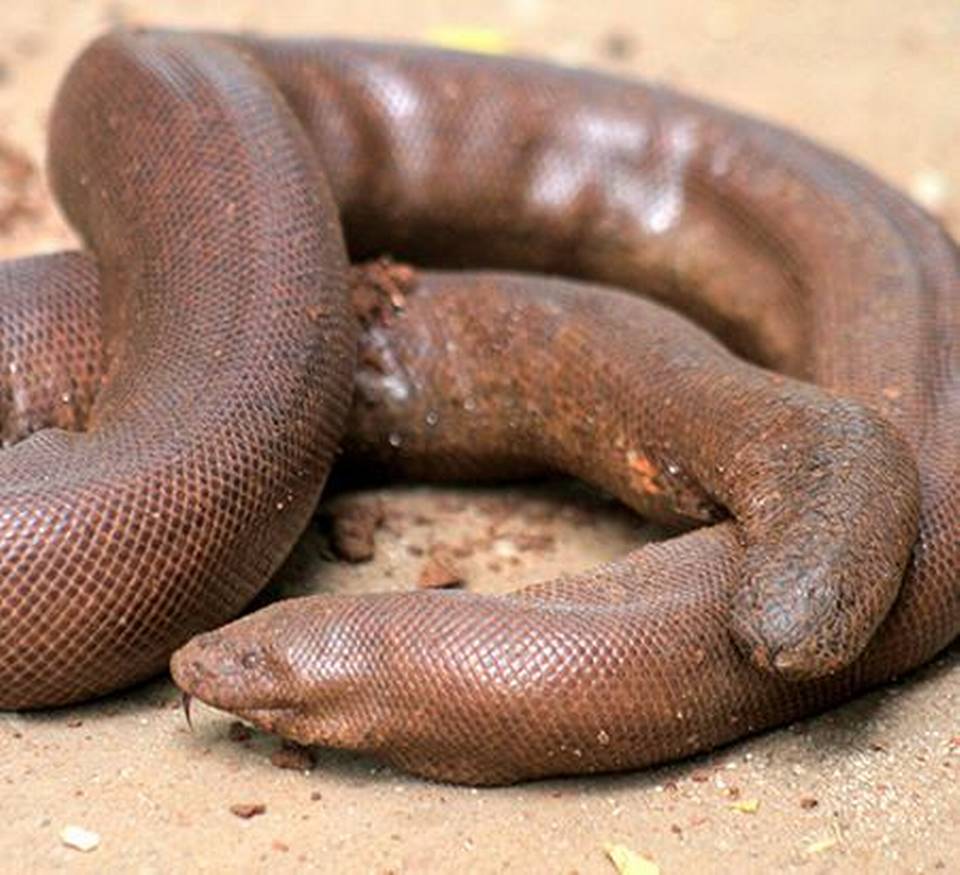
- It is a rare non-poisonous snake that is used for making certain medicines, cosmetics and in black magic, and is in huge demand in the international market.
- It is found in whole of India excluding North-east states after North-Bengal; also not found in Indian islands.
- Among layman it is famous as "Two-headed Snake" due to the presence of very thick tail having rounded end.
- The trade and possession of the red sand boa is an offence under the Wildlife Protection Act 1972. The species is listed under Schedule 4 of the Act. Also, it is listed in CITES Appendix II.

